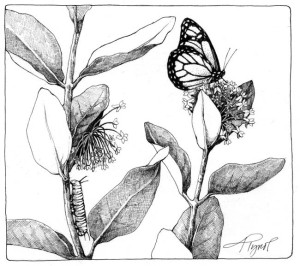
Kids love the snowy seeds of the milkweed plant. Farmers take a dimmer view, wishing those seeds didn’t colonize their pastures quite so readily. Most everyone else, by and large, ignores milkweed, except for one particular critter: the monarch butterfly.
Starting in late July, milkweed plants bloom in baseball-size clusters of flowers. The flowers are generally described as pink, but they can be white, green, even brown, and are often all of these colors mixed together. They are beautiful flowers in that over-wrought, Victorian way, but the flower clusters can be sparse or patchy, and they tend to flop or nod. It’s a plant that, in flower, looks like it has just woken up and hasn’t pulled itself together yet.
Leaves of the common milkweed are smooth, dark green ovals, three or four inches long. If you tear a leaf or break a stem, a milky-looking fluid bleeds out. This is the “milk” that gives the plant its name, but there is nothing milk-like about it, other than its appearance. The stuff is the plant’s sap, and it is a kind of latex. It can be irritating to the skin and is poisonous, particularly affecting the heart, if swallowed.
Milkweed would be just another of many wildflowers that grow in our area, except for one thing. The black-, yellow-, and white-striped caterpillar of the monarch butterfly feeds only - only - on milkweed leaves. Just about any kind of milkweed will do, but it has to be a true milkweed.
Monarch caterpillars are one of the few animals that can eat milkweed leaves without feeling the effects of the plant’s poisonous sap. In fact, the toxin makes the caterpillars unpleasant-tasting, even sickening, to other creatures, and persists into the butterfly stage, making the butterflies sickening to potential predators as well.
Common milkweed, while still living up to its designation as “common,” has been in some trouble lately. According to the American Farmland Trust, one million acres of farmland per year were developed - into houses, shopping centers, parking lots, and other uses - between 1992 and 1997. And, it says, the rate of development has only increased since then. When farms disappear, milkweed tends to also, making it hard for monarch caterpillars to find a meal.
Originally, milkweed was a flower of prairies, meadows, and grasslands. When prairies were turned into farms, milkweed became a plant that thrived on the margins of agriculture. It was found at the edges of fields, and along brooks and borders. It even survives mechanical tilling, growing between rows of crops.
Around here, though, there are enough old farm fields filled with common milkweed for Bob Popp, botanist for Vermont’s Nongame and Natural Heritage Program, to call the plant “ubiquitous.”
There are six or seven types of true milkweed in Vermont, Popp reports. They are all variations on a theme typified by the common milkweed.
Swamp milkweed, for example, is fairly common. It too has pink-to-purple flower clusters, only a little less globe-like. It has much pointier leaves than common milkweed, and can easily be mistaken for Joe Pye weed. The big seedpod and the fluffy white seeds are the giveaway that it’s a milkweed, though.
Blunt-leaved milkweed has wavy-edged leaves and is found in sandplains. It is listed as threatened in New Hampshire and Vermont. In Vermont, it’s only found at three or four sites, Popp says.
Butterfly weed is a common garden plant that is now difficult to find in the wild in our area. It’s listed as threatened in Vermont. This milkweed is far off the general theme, with bright orange flowers in an umbrella shape and very narrow leaves.
Because milkweed and monarchs are so closely connected, milkweed is a good plant to include in a butterfly garden. Best of all, many people find milkweed already among the plants that grow as weeds in their gardens, or along field edges. All you have to do is leave it alone.
Certainly, nabbing a few mature, brown seedpods from a nearby farm field or brush patch and scattering the downy seeds at home will give you a head start on next year’s plants. Butterfly weed, which hasn’t been seen in the wild in Vermont in about 20 years, according to Popp, is commonly found in nurseries.
Some of the more unusual varieties of milkweed native to Vermont and New Hampshire are available as seed from native plant nurseries.
For anyone who has more than his or her share of “volunteer” milkweed and hates weeding, here’s your excuse: it’s not that you don’t want to spend time on that chore, it’s just that you’re helping out the butterflies. It’s nice to know that making a little room for milkweed in our lives will also bring the beauty of the monarch butterfly.


Discussion *